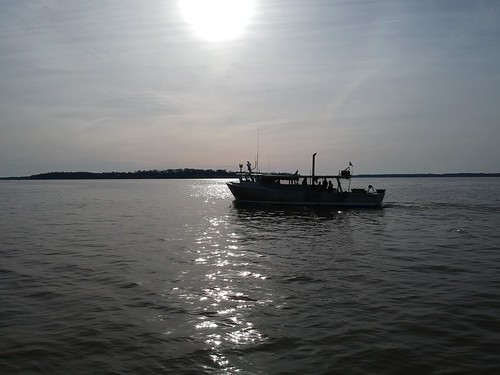Maryland Department of Natural Resources Putting Forth New Regulations to Protect Spawning Striped Bass
The Maryland Department of Natural Resources is submitting striped bass emergency regulations this week in an effort to bolster the species’ spawning population. These specific actions in Maryland will complement additional actions that will be implemented coastwide in 2024 by the Atlantic States Marine Fisheries Commission. Maryland Department of Natural Resources Secretary Josh Kurtz says Maryland waters serve as the spawning grounds for many of the striped bass that migrate up and down the East Coast and that they take their leadership role in managing the overall population seriously.

DNR biologists survey and tag striped bass in the northern reaches of the Chesapeake Bay as part of the annual spring survey of the spawning population. Photo by Stephen Badger, Maryland Department of Natural Resources
Additional Information from the Maryland Department of Natural Resources
The emergency regulations propose to extend two periods already closed to targeting striped bass in the Chesapeake Bay and on the Susquehanna Flats next year. These extensions would result in the elimination of the Maryland Striped Bass Trophy season (May 1 to May 15) and the catch-and-keep fishery on the Flats (May 16 to May 31) in 2024.
These suggested changes come after five years of below average spawning success for striped bass, also known as rockfish. The regulations are being presented to the Maryland General Assembly’s Joint Committee on Administrative, Executive and Legislative Review for its consideration. A public hearing on the draft regulations would take place if called for by a committee member.
A comprehensive striped bass stock assessment scheduled to be released in 2024 will determine how the species has responded to previous management actions made by Maryland and other coastal states during the last few years.
While recent research has suggested that environmental factors, such as warm winters and low water flows, are significant factors influencing spawning success, DNR officials believe it is critical to take measures now to protect the adult spawning stock of striped bass by reducing fishing mortality associated with harvest along with fish that die after being caught and released.
“The recent recruitment numbers of juvenile striped bass show that additional management efforts are necessary to protect the overall population,” DNR Fishing and Boating Services Director Lynn Waller Fegley said. “We believe the proposed regulations will help protect the spawning stock of striped bass in Maryland. Increasing the spawning stock will enhance the odds of successful spawning when environmental conditions are right.”
The Chesapeake Bay is the primary spawning and nursery area for 70% to 90% of the striped bass of the Atlantic coast. Striped bass is Maryland’s state fish and the state’s most important commercial and recreational fish species.
In Maryland, April is already closed to targeting striped bass, and under the emergency regulations this period would extend through May 15. The striped bass trophy season has taken place during the first two weeks of May in the past. This is part of the time period when large female striped bass typically make their way up the Chesapeake Bay to spawn in the same rivers where they hatched. The emergency regulation is aimed at protecting these fish before and after they spawn.
After May 15, fishing of striped bass will be allowed in portions of the Bay under updated slot limits expected to be set by the Atlantic States Marine Fisheries Commission (ASMFC) in early 2024.
The emergency regulations would also close the current catch-and-keep fishery for striped bass at the Susquehanna Flats region from May 16 to May 31 through an extension of the previously closed season on the Flats area from April 1 to May 15 (see maps for current regulations). This area is where many adult striped bass end their journey from the Atlantic Ocean to spawn.
“We will continue to deliberate internally and with our Bay and coastal partners to address overall mortality of striped bass for the future, however, the emergency regulations are intended to protect the fish when they are the most vulnerable during the critical spawning period,” DNR Associate Director for Tidal and Coastal Management and Science Michael Luisi said. “All sectors of the striped bass fishery will need to work together to preserve the spawning stock for the future of this important recreational and commercial fishery along the Atlantic coast and in Maryland’s portion of the Chesapeake Bay.”
DNR officials encourage anglers to pursue other fish, such as blue catfish and northern snakehead instead of striped bass. Blue catfish and snakeheads are invasive species and harvesting them contributes to a healthier ecosystem in the Bay.
If approved, the draft regulations would take effect in tandem with regulations from the ASMFC, which is considering limits to the number and size of striped bass that can be caught in the Bay and along the Atlantic Coast to reduce striped bass mortality.
Emergency regulations can take effect for 180 days, so these proposed changes would affect the spring portion of the 2024 fishing season. If the state seeks to continue these measures beyond that, it would require a rule change and a more extensive public comment process.


